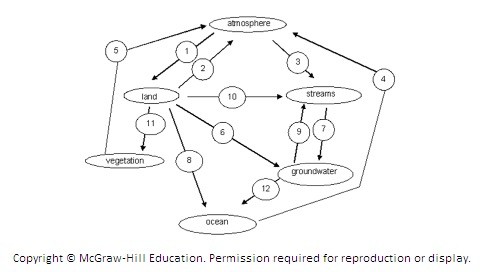The following diagram illustrates the Hydrologic Cycle. Match the item below to the arrow on the diagram (note: some items may be used for more than one arrow).Example: If you believe that water passes from clouds to streams by evaporation then choose that answer for arrow 3. Match the item below to the arrow on the diagram for number 10. (Note: some items may be used for more than one arrow).
Match the item below to the arrow on the diagram for number 10. (Note: some items may be used for more than one arrow).
A. Evaporation
B. Infiltration
C. Transpiration
D. Runoff
E. Precipitation
Answer: D
You might also like to view...
In 2010, geologists working for the U.S. military operations in Afghanistan discovered a literal treasure trove of mineral deposits with a preliminary estimated value at nearly U.S. $1 trillion. So far, no proposals have been made for extracting these resources, but already parallels have been drawn to the many dimensions of human rights issues that have plagued coltan production in the Congo, oil drilling in Nigeria, and the "blood diamonds" of Sierra Leone. The U.S. Agency for International Development (USAID) manages a program called the Mining Investment and Development for Afghanistan Sustainability (MIDAS) project, whose goal is to assist the Afghan government in responsibly developing the nation's mining industry.
For the Afghan people, which of the following would be the most useful benefit from mining profits?
Evaluate this statement: "Earthquake damage depends primarily on the magnitude of the quake."
A) This statement is true. B) This statement is true, but earthquake damage also depends on the proximity to the epicenter and the characteristics of materials through which the earthquake passes. C) This statement is false; the most important factor in earthquake damage is the quality of building materials used. D) This statement is false; the most important factor in earthquake damage is the location's proximity to the epicenter.
Standard time zones
A) are 15° wide because Earth rotates that distance in one hour. B) have yet to be generally established. C) are spaced at 5° intervals of longitude in North America. D) are arbitrarily set based on international political boundaries. E) are only used in the developed countries.
Rainforests
A. can be either temperate or tropical. B. are only found in the tropical latitudes.